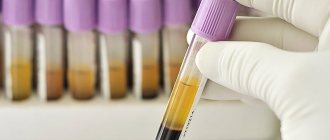Immunoglobulin tests: if you have allergies
The content of the article
For many years, eliminating sources of allergies remains the best method of getting rid of this problem. Naturally, to exclude allergens, they must first be detected. This is precisely why immunoglobulin tests are carried out, which are an obligatory part of a comprehensive diagnosis of allergies.
Having received the results, the doctor judges the presence of allergies not by the clinical reaction (symptoms), but by the level of antibodies - proteins - immunoglobulins of class E (IgE). Immunoglobulin E controls allergic reactions and destroys parasites.
References
- Godwin, L., Crane, J. Biochemistry, ImmunoglobulinE (IgE). StatPearls Publishing, 2021.
- MAYO Clinic Laboratories : website / Test ID: IGE Immunoglobulin E (IgE), Serum, 2021.
- Derya, U., Gelincik, A., Elitok, A. et al. Impact of high serum Immunoglobulin E levels on the risk of atherosclerosis in humans. AsiaPacAllergy, 2021. - Vol. 7(2). — P. 74-81.
- Joshi, A., Iyer, V., Boyce, T. et al. Elevated serum immunoglobulin E (IgE): when to suspect hyper-IgE syndrome-A 10-year pediatric tertiary care center experience. AllergyAsthmaProc., 2009. - Vol. 30(1). — P. 23-27.
- American Academy of allergy asthma and immunology: website / AAAAI, 2021. - URL: https://www.aaaai.org/ (accessed March 15, 2021).
Why is a test for total immunoglobulin IgE taken?
Testing for total immunoglobulin IgE is an important element in the comprehensive diagnosis of allergies. The human body, when in contact with an allergen - household, food, pollen, etc., produces an immune response, which is accompanied by the production of immunoglobulins. In particular, immunoglobulins appear in the blood - Ig class E. Antibodies are present in the blood serum and are detected during analysis. This component remains in the body for about 5 days, maximum two weeks.
The level of immunoglobulin E depends on the gender, age and weight of the patient. Let's say, for a 17-year-old boy, the normal value does not exceed 90 IU/ml. In patients with allergies, the level of specific IgE antibodies is sharply increased.
However, if a
analysis of total immunoglobulins in children or adults shows the norm, this does not mean the absence of allergies. About 30% of allergic diseases do not lead to an increase in the rate. And if there are serious suspicions that the patient has an allergy, the doctor must conduct an analysis for specific immunoglobulins to different groups of allergens and to individual allergens.
Why do you need to be tested for specific antibodies?
Diagnostics of antibodies of the IgE and IgG classes establishes the patient’s body’s reaction to specific groups of substances, and also determines the nature of these reactions. For example, immunoglobulin G is involved in allergic reactions that are of the delayed type, that is, the body’s reaction occurs only several hours (sometimes days) after the allergen penetrates it. While class E antibodies are involved in immediate-type reactions, in other words, it takes only a few minutes for the body to respond to the penetration of the allergen.
Function of immunoglobulin E in the body
Immunoglobulin E is a specific indicator of allergies. Allergens that penetrate or come into contact with tissues interact with immunoglobulins of this type, as a result of which they bind into complexes, and the following allergic reactions occur at the sites of exposure:
- there is a runny nose, frequent sneezing, and increased sensitivity of the nasal mucosa (rhinitis);
- the shape and color of the skin changes (allergic rash);
- due to inflammation of the bronchi, a cough occurs (bronchitis);
- as a result of a decrease in the lumen of the bronchi, wheezing, difficulty breathing, shortness of breath (asthma) are noted;
- the development of an immediate allergic reaction to an irritant, often resulting in death (anaphylactic shock).
In terms of their structure, immunoglobulins E belong to gamma globulins, the production of which is responsible for B lymphocytes. They play a leading role in the development of atopic diseases: urticaria, allergic rhinitis, atopic dermatitis, bronchial asthma. In addition, class E immunoglobulins form an antiparasitic immune response to roundworms, toxoplasma, trichinella, echinococcus, nematodes and other types of parasites.
Normally, immunoglobulin E is contained in blood serum in small quantities (30-240 µg/l). The highest antibody levels are observed in late spring, and the lowest in early winter. Due to the active flowering of most plants, in May the air is saturated with pollen, which is a very strong allergen.
Immunoglobulins E appear in the human body during prenatal development. From birth to adolescence, there is a gradual increase in their level. A decrease in the amount of immunoglobulin E is observed in older people. Sharp fluctuations in the level of immunoglobulin E may indicate certain diseases.
A blood test for total immunoglobulin is usually prescribed for people suffering from bronchial asthma, atopic dermatitis, hay fever and helminthiasis. It is recommended to donate blood for immunoglobulin in order to identify drug and food allergies and possible hereditary diseases.
Make an appointment
How is the analysis performed?
If immunoglobulin tests to determine allergens, blood is always taken from a vein. Then a test is carried out for groups of allergens that are suspected by the doctor. The set of tests is determined after observing when the patient experiences allergic reactions. Each test belongs to a specific panel of allergens, which combine the following groups of specific immunoglobulins:
- household allergens;
- allergens of mold fungi;
- plant allergens;
- helminth allergens;
- occupational allergens;
- animal allergens;
- food allergens.
This list is very long, since all allergen panels include at least 2-3 specific items (in some cases this figure reaches several dozen). In most cases, the doctor will send the patient for tests from groups of specific immunoglobulins that seem most likely. Carrying out such tests allows you to diagnose allergic reactions to dogs, cats and other pets, and detect allergies to a variety of plants. If the patient has a food allergy, this technique is most effective.
Do you need any preparation for testing?
Tests for immunoglobulins for allergies must be carried out on an empty stomach; two days before this, it is advisable to abstain from spicy and fatty foods, and avoid drinking alcohol. No other preparation is required.
Immunoglobulin tests for anemia
Anemia is a condition of the body in which there is a reduction in hemoglobin and the number of red blood cells in a person’s blood. The result of this may be insufficient oxygen supply to the body tissues, and there is a risk of developing heart failure. An immunoglobulin test is a mandatory element of diagnosis if anemia is suspected.
Every year, approximately 1,360,000 cases of anemia are registered in the Russian Federation, and this figure is gradually increasing.
When to get tested
The disease can reveal itself through the following symptoms:
- weakness, fatigue even in the morning, difficulty breathing during exercise;;
- pallor (this is especially expressed on the eyelids, gums and bases of the nails);
- mild excitability and rapid heartbeat;
- inability to concentrate;
- brittle nails;
- small cracks in the corners of the mouth;
- inflamed smooth tongue;
- blood impurities in the stool and so on.

Immunoglobulin tests for anemia
As part of the analysis, the concentration of immunoglobulins of classes G, A, ME, D in the patient’s blood is studied.
- IgG immunoglobulins.
These are antiparasitic and anti-infective antibodies that can kill a fungus, virus or infection and prevent them from developing. In addition, this immunoglobulin is responsible for the dehydration of toxins that are produced by the pathogen. It is IgG that guarantees fetal immunity during pregnancy and is responsible for maintaining long-term immunity. - IgA immunoglobulins.
Antibodies support local mucosal immunity. Their work is activated during skin infections. An increase in the level of IgA immunoglobulins can occur due to intoxication, chronic liver diseases, and alcoholism. - IgM immunoglobulins
. They are called anxiety antibodies, the number of these antibodies increases rapidly at the beginning of any disease; in fact, they serve as rapid response agents, guaranteeing the primary protection of the human body in case of infection. - Immunoglobulins IgD, IgE.
These antibodies belong to the category of specific antibodies; in the body of a healthy person, their appearance is possible in the case of atopic allergies and worms.
Test for total immunoglobulin
sets the concentration of certain antibodies. This information makes it possible to diagnose a potential disease. As a rule, a test for immunoglobulins is an element of a comprehensive diagnosis necessary to make a correct diagnosis.
How to prepare for immunoglobulin tests for anemia
If the patient is to undergo tests for immunoglobulins, it is advisable to completely avoid fatty and fried foods two days before the examination, and alcoholic beverages are also prohibited. As a rule, the examination is carried out in the morning; 8 hours before the patient should not eat (the amount of plain water is not limited). No other preparation for the study is required.
Mysterious immunoglobulins: deciphering the analysis
Certain classes of immunoglobulins tell the dermatologist about the dynamics and stages of the disease, which makes it possible to predict risks and prescribe diagnostic and therapeutic procedures to the patient correctly.
Of course, without a medical education, a person will not be able to correctly decipher immunoglobulin tests on his own, but you can still understand whether there is cause for concern.

Immunoglobulin A
Immunoglobulins are a protective factor of human mucous membranes and belong to the b-globulin fraction. The concentration of class A antibodies in the patient's body is approximately 15% of the total number of immunoglobulins in the blood serum. These antibodies are found in saliva, mucous secretions, tear fluid, and milk.
Normally, the results of an immunoglobulin A test should not go beyond 0.9-4.5 g/l. If the indicators do not correspond to the norm, the following reasons are possible:
- An increase in the concentration of class A antibodies may indicate chronic liver diseases, rheumatoid arthritis, systemic lupus erythematosus, glomerulonephritis, myeloma.
- Reduced concentration - about radiation sickness, taking immunosuppressants, poisoning (xylene, gasoline, toluene), liver cirrhosis, and so on.
Immunoglobulin M
Immunoglobulin M belongs to the γ-globulin fraction, its concentration in the body is approximately 10% of the total concentration of immunoglobulins in the blood serum. It is class M antibodies that appear first after the introduction of an antigen. The IgM group includes blood group antibodies, anti-infective antibodies, and rheumatoid factor.
Immunoglobulin M test
Normally it should show 0.5-3.5 g/l. If the indicators deviate from the norm, this may indicate the following problems.
- An increased concentration of class M antibodies in the patient’s body may indicate acute fungal, viral, parasitic and bacterial infections, liver cirrhosis, hepatitis, systemic lupus erythematosus, rheumatoid arthritis, systemic vasculitis, candidiasis.
- A reduced concentration of class M antibodies in the patient’s blood can serve as a signal for splenectomy, taking cytostatics, antidepressants, radiation sickness, poisoning (xylene, toluene).
Reasons for increased immunoglobulin E levels
An increase in the level of immunoglobulin of this class is observed in persons suffering from the following pathologies:
- allergic diseases (allergic conjunctivitis, sinusitis, rhinitis, anaphylaxis, atopic dermatitis, atopic bronchial asthma, urticaria, pollen, food, drug allergies, angioedema, allergic gastroenteropathy, etc.);
- parasitic infestations (echinococcosis, amoebiasis, ascariasis, nematode, hookworm, etc.);
- bronchopulmonary aspergillosis;
- immune diseases (Job syndrome, Wiskott-Aldrich syndrome, recurrent pyoderma, DiGeorge syndrome (thymic aplasia), periarteritis nodosa, Neumann syndrome, hypereosinophilia of unknown origin;
- infectious mononucleosis;
- selective deficiency of immunoglobulin A;
- liver cirrhosis of alcoholic origin.
Immunoglobulin G
Immunoglobulin G belongs to the γ-globulin fraction, its concentration in the body is 70-75% of the number of immunoglobulins in the blood serum as a whole. Supports passive immunity.
Normally, an analysis for immunoglobulin G should show a value in the range of 7-17 g/l. If the test results are not normal, the problem may be as follows.
- Excessive concentrations of class G antibodies may indicate chronic and acute infectious diseases, infectious mononucleosis, multiple myeloma, rheumatoid arthritis, autoimmune diseases, systemic lupus erythematosus, HIV, rheumatism.
- Reduced concentration indicates physiological contraction in children under six months, radiation sickness, liver cirrhosis, poisoning (gasoline, toluene, xylene) and so on.
IgG is higher than normal
A high concentration of IgG is observed in the following cases:
- acute form or relapse of the disease;
- remission after primary infection;
- diseases of the respiratory system, gastrointestinal tract and genitourinary system in acute, subacute and chronic forms;
- liver diseases: hepatitis (autoimmune or viral);
- cirrhosis, including alcoholic;
- lupus erythematosus (damage to the skin and connective tissue);
- myeloma of the IgG type;
Immunoglobulin E
Immunoglobulin E controls the allergic reactions that occur and takes on the function of destroying parasites.
- If immunoglobulin E is elevated, one can assume that the patient has atopic dermatitis, urticaria, allergic rhinitis and hay fever, the presence of worms, myeloma, bronchial asthma, allergies to medications and foods.
- If immunoglobulin E is low, this is also bad. This condition is observed with tumors, Louis-Barr syndrome, and hereditary hypogammaglobulinemia.
Where to get tested for immunoglobulins in St. Petersburg
You can undergo tests for immunoglobulins at your own request (for example, if you have allergy symptoms) or as prescribed by your attending physician at the Diana Medical Center in St. Petersburg. Taking tests with us provides the following advantages: the accuracy of the results, the speed of obtaining them, the absence of queues and affordable prices. Here you can get advice from an experienced specialist about decoding.
If you find an error, please select a piece of text and press Ctrl+Enter
Reduced IgG
Deficiency of this class of antibodies is detected in the following cases:
- viral diseases in chronic form;
- allergic diseases, including atopic dermatitis;
- deficiency of vitamin B12 in the body;
- chronic inflammatory processes in the large intestine (ulcerative colitis, Crohn's disease);
- human immunodeficiency virus (HIV infection);
- nephrotic syndrome (damage to the glomeruli of the kidneys);
- leukemia (blood cancer);
- surgery to remove the spleen (splenectomy);
- general variable immunodeficiency (a disease in which there is a violation of the production of immunoglobulins);
- Bruton's disease (immunodeficiency due to gene mutation). In this case, there is a congenital deficiency of immunoglobulin G;
- hypogammaglobulinemia (B-lymphocyte deficiency);
- hyper-IgM syndrome (immunoglobulin deficiency caused by a hereditary disorder of the immune system);
- Louis-Bar syndrome (immune T-cell deficiency);
- Wiskott-Aldrich syndrome (a genetically determined recessive disease characterized by the presence of eczema);
- exposure of the patient to ionizing radiation;
- muscular dystrophy (genetic).









